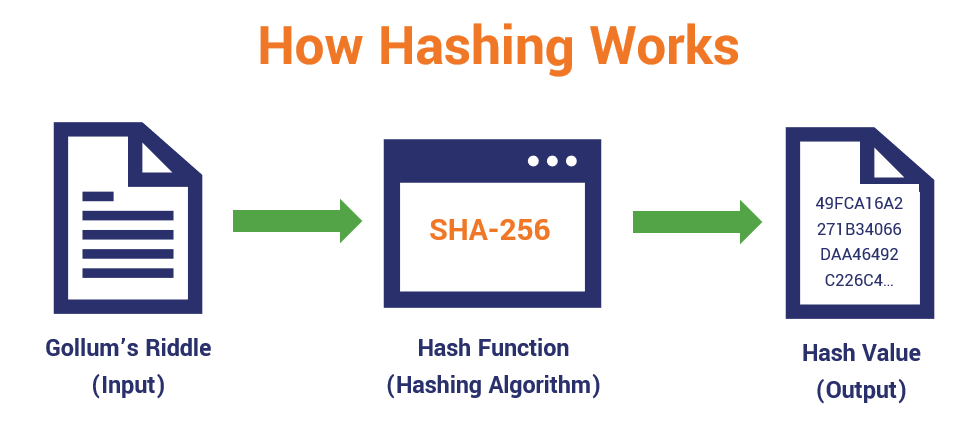Hashing is a fundamental concept of cybersecurity that helps protect sensitive data and financial information from unauthorized access to ensure data integrity.
Understanding how hashing works and its various applications is essential for maintaining a strong security posture in a world faced with cybersecurity threats that are increasing in severity and frequency as the years go by.
An interesting statistic to put all of this in perspective is that between 2021 and 2023 alone, the number of data breaches rose by a staggering 72%, with nearly 350 million victims.
Another statistic worth noting is that in 2023, the Internet Crime Complaint Center received more than 880,000 complaints of data breaches from the American public, which amounted to personal losses of $12.5 billion. That’s a 10% increase in complaints and a 22% increase in losses suffered compared to 2022.
Whenever you pick up a device, you are faced with increasingly severe threats of cyber crimes, so being prepared is crucial. Knowing what hashing is, how it works, and what types there are can help keep you safe.
So, what is hashing in cybersecurity? Keep reading to find out!
Table of Contents
- Key Takeaways
- What Is Hashing in Cybersecurity?
- Types of Hashing Algorithms
- Benefits of Hashing in Cybersecurity
- What is the Difference Between Hashing and Encryption?
- Common Applications of Hashing in Cybersecurity
- Best Practices for Implementing Hashing in Cybersecurity
- Is Hashing Sufficient for Comprehensive Cybersecurity?
- Frequently Asked Questions
Key Takeaways
- Hashing transforms data into a fixed-size output, making it ideal for ensuring data integrity and securing sensitive information.Hashing transforms data into a fixed-size output, making it ideal for ensuring data integrity and securing sensitive information.
- Several algorithms, like SHA, MD5, LANMAN, and NTLM, are commonly used for hashing in cybersecurity, each with specific strengths and weaknesses.Several algorithms, like SHA, MD5, LANMAN, and NTLM, are commonly used for hashing in cybersecurity, each with specific strengths and weaknesses.
- Hashing serves various applications, such as secure password storage, digital signatures, and verifying file integrity.Hashing serves various applications, such as secure password storage, digital signatures, and verifying file integrity.
- Implementing best practices like strong algorithms, salting, and secure storage further enhance the effectiveness of hashing in cybersecurity.Implementing best practices like strong algorithms, salting, and secure storage further enhance the effectiveness of hashing in cybersecurity.

What Is Hashing in Cybersecurity?
Hashing in cybersecurity is transforming data of any size into a fixed-size output using a mathematical algorithm. This output, known as a hash or hash value, uniquely represents the original data.
Hashes are one-way functions, meaning it is practically impossible to reverse the process and obtain the original input data from the hash value alone. This property makes hashing an essential tool for securing sensitive information.
In simple terms, hashing in cybersecurity is a way to take any kind of data (like a file or password) and use a special mathematical formula to turn it into a short, fixed-size code, called a hash.
This hash acts like a unique fingerprint for the data. Once the data is turned into a hash, you can’t go backward to find the original information, which makes it useful for securing things like passwords or verifying data without revealing it.
Now that we know what hashing in cybersecurity is, let’s look at an example.
Example of Hashing in Cybersecurity
One common example of hashing in cybersecurity is the storage of user passwords. Instead of storing passwords in plain text, which would be a significant security risk, systems hash them before storing them.
When a user enters their password to log in, the system hashes the entered password and compares it with the stored hash value. If the hashes match, the user is authenticated without storing or exposing the actual password at any point.
Although the basic principle of hashing in cybersecurity may be the same across the board, different types of hashing algorithms are used to achieve this high level of security. Let’s move on and find out what these are.
Types of Hashing Algorithms
Several hashing algorithms are commonly used in cybersecurity to protect data and ensure its integrity. These include SHA, MD5, and LANMAN and NTLM.
Let’s explore some of the most popular ones:
SHA (Secure Hash Algorithm)
The SHA family consists of cryptographic hash functions designed by the National Security Agency (NSA) and published by the National Institute of Standards and Technology (NIST).
Here are the three main types:
SHA-1
SHA-1 produces a 160-bit hash value and was once a widely used algorithm for data integrity verification. However, it’s now considered insecure due to susceptibility to collision attacks, where two different inputs produce the same hash output. Because of these vulnerabilities, SHA-1 has been largely deprecated in favor of more secure options.
SHA-2
SHA-2 is a family of algorithms, including SHA-224, SHA-256, SHA-384, and SHA-512, which produce hash values of 224 to 512 bits. SHA-2 provides improved security over SHA-1 and is today’s most commonly used hashing standard. Its longer hash lengths make it more resistant to brute-force attacks, and it is widely employed in secure protocols like SSL/TLS and digital signatures.
SHA-3
SHA-3, the most recent member of the SHA family, was selected through a public competition to provide an alternative to SHA-2. It utilizes a unique mathematical method called sponge construction, which differs from SHA-1 and SHA-2’s Merkle–Damgård structure.
This design makes SHA-3 resistant to certain attack types affecting its predecessors. SHA-3 serves as a fallback should weaknesses in SHA-2 ever be discovered, enhancing future-proofing in cryptographic security.
MD5 (Message Digest Algorithm 5)
MD5, or Message Digest Algorithm 5, was developed by Ronald Rivest in 1991 as an upgrade to the earlier MD4 algorithm. It produces a 128-bit hash value, which is typically shown as a 32-character hexadecimal string.
Due to its speed and efficiency, MD5 became widely adopted for verifying file integrity and hashing passwords. By generating unique “fingerprints” for data inputs, MD5 helps ensure that files haven’t been altered or corrupted during transfer.
However, researchers discovered vulnerabilities in MD5, particularly its susceptibility to collision attacks. In a collision attack, two different data inputs result in the same hash value. In simple terms, a collision attack is like finding two different keys that open the same lock.
This weakness compromises its security, making it unsuitable for high-stakes applications like digital signatures or SSL certificates. Despite this, due to its speed, MD5 is still frequently used for non-critical purposes, like basic file integrity checks. For more secure applications, algorithms like SHA-2 or SHA-3 are recommended.
LANMAN and NTLM
LANMAN (LAN Manager) and NTLM (NT LAN Manager) are hashing algorithms Microsoft uses to store passwords in Windows systems.
Here’s a quick look at both.
LANMAN
LANMAN, or LAN Manager, is an older hashing algorithm developed by Microsoft for password storage in early Windows systems. LANMAN uses a simplistic hashing method that is now considered highly insecure.
It only supports uppercase letters and divides passwords into two seven-character chunks before hashing each one individually, which makes it easy to crack. As a result, LANMAN hashes are highly vulnerable to brute-force attacks, and due to this weakness, LANMAN is no longer recommended or widely used for secure systems.
NTLM
NTLM, or NT LAN Manager, was developed as a more secure successor to LANMAN for password hashing and authentication on Windows systems. NTLM employs a challenge-response authentication protocol and stores password hashes using the MD4 algorithm.
It does not split passwords into chunks, making it more resistant to certain types of attacks than LANMAN. However, NTLM has also been criticized for vulnerabilities and has been largely replaced by more secure protocols like Kerberos in modern Windows systems.
With the different types of hashing algorithms covered, let’s examine the benefits of hashing in cybersecurity.
Benefits of Hashing in Cybersecurity
Hashing has several important benefits that make it a valuable tool in your cybersecurity arsenal. Let’s discuss how hashing helps ensure data integrity, secure password storage, enable efficient data comparison, and facilitate digital signatures and message authentication.
Here’s why hashing is so important:
Ensuring Data Integrity
Hashing helps detect data changes or tampering. When you hash a piece of data, such as a file or message, you create a unique hash value that serves as a digital fingerprint. If the data is altered in any way, even by a single bit, the resulting hash value will be entirely different.
By comparing the original hash value with the hash of the current data, you can quickly determine whether the data has been modified. This integrity check is particularly useful when transmitting data over networks or storing it on external devices, as it allows you to verify that the data has not been corrupted or tampered with during transit or storage.
Secure Password Storage
Storing hashed passwords protects them from unauthorized access. Instead of storing passwords in plain text, which would be a significant security risk, systems store the hash values of the passwords.
When a user enters their password to log in, the system hashes the entered password and compares it with the stored hash value. This approach ensures that even if an attacker gains access to the password database, they would only see the hashed values, not the actual passwords.
Hashing algorithms like bcrypt, scrypt, or PBKDF2 are specifically designed for password hashing, as they include additional security measures such as salting and key stretching to make cracking the hashes more difficult. This benefit is one reason that high-networth individuals at risk of cyber threats should strongly consider using hashing.
Efficient Data Comparison
Comparing hash values is faster than comparing original data. When you need to compare large datasets or files, directly comparing the original data can be time-consuming and resource-intensive. By comparing the hash values instead, you can quickly determine whether two datasets or files are identical.
This efficiency is particularly useful in applications like file integrity monitoring, where you need to regularly check if files have been modified. Instead of comparing the entire contents of the files each time, you can simply compare their hash values, which is much faster and requires fewer computational resources.
Digital Signatures and Message Authentication
Hashing is used to create and verify digital signatures, which ensure the authenticity and integrity of a message or document. When creating a digital signature, the signer first hashes the message or document to create a hash value. They then encrypt this hash value using their private key, creating the digital signature.
The recipient can verify the digital signature by decrypting it using the signer’s public key and comparing the resulting hash value with the hash they compute from the received message or document. If the two hash values match, it proves that the message or document has not been altered since it was signed and that the private key owner indeed signed it.
Hashing is also used in message authentication codes (MACs), which provide message authentication and integrity. A MAC is generated by combining a secret key with the message data and then hashing the result. The recipient, who also possesses the secret key, can verify the MAC to ensure that the message has not been tampered with and that it originated from the expected sender.
What is the Difference Between Hashing and Encryption?
In cybersecurity, hashing and encryption are important concepts, but they have different functions and unique properties. Let’s examine encryption to see how it differs from hashing.
What Is Encryption?
Encryption converts readable data, known as plaintext, into an unreadable format called ciphertext using an encryption algorithm and a secret key. This process is reversible, meaning anyone with the correct decryption key can convert the ciphertext back to its original plaintext form.
Encryption primarily protects data confidentiality, ensuring that only authorized individuals with the correct key can access the original information. It’s a critical method for securing sensitive data, whether stored or transmitted over networks.
How Hashing Differs from Encryption
Hashing differs from encryption in several key ways, including the reversibility of the action, the focus, and the output size.
Here’s how they differ:
Irreversible vs. Reversible Processes
Hashing is a one-way function; once data is hashed, it cannot be reversed to reveal the original information. This makes it ideal for verifying data integrity, as any change to the input data results in a different hash value, making it easy to detect tampering.
Encryption, on the other hand, is a two-way function. Encrypted data can be reverted back to its original form using a decryption key. This reversibility is essential for protecting sensitive data and allowing authorized access to the original information while preventing unauthorized access.
Focus on Integrity vs. Confidentiality
Another key distinction lies in their primary purposes: hashing is focused on data integrity, while encryption is aimed at data confidentiality.
Hashing helps verify that data has not been altered, which is why it is widely used in password storage and digital signatures.
Encryption, by contrast, converts data into unreadable ciphertext to ensure privacy, which makes it crucial for securing data at rest and in transit.
Fixed-Size Output vs. Variable Output Sizes
Finally, hashing produces a fixed-size output regardless of the input size. For example, the SHA-256 algorithm consistently generates a 256-bit hash value, providing a uniform way to verify data integrity.
Encryption results in variable output sizes that depend on the algorithm and input data. This flexibility helps protect a wide range of data types, allowing encryption to secure entire files, messages, or transmissions.
With the differences between hashing and encryption covered, let’s discuss the common applications of hashing in cybersecurity.
Common Applications of Hashing in Cybersecurity
Hashing is widely used in various aspects of cybersecurity, ensuring the integrity and security of sensitive data. Let’s explore some of the most common applications of hashing in the digital world, such as password verification, file integrity verification, and digital signature verification.
Here’s what hashing is most commonly used for:
Password Verification
When you create an account on a website or application, your password is hashed and stored in the system’s database. Each time you log in, your password is hashed again and compared to the stored hash value.
If the two hash values match, the system authenticates you without ever storing or exposing your password. This process helps protect your password even if the database is compromised, as the attacker would only have access to the hashed values, not the original passwords.
If you’re looking for extra password protection, using a password manager is highly recommended.
File Integrity Verification
Hashing plays an important role in verifying the integrity of files and detecting any unauthorized changes. When you download a file from a trusted source, the provider often includes the file’s hash value.
After downloading the file, you can calculate its hash value and compare it to the provided one. If the hash values match, you can be confident that the file has not been altered during the download process.
Digital Signature Creation and Verification
Digital signatures rely on hashing to ensure the authenticity and integrity of digital documents or messages. The signer first hashes the document to create a unique hash value when creating a digital signature.
They then encrypt this hash value using their private key, generating the digital signature.
The recipient can verify the signature by decrypting it using the signer’s public key and comparing the resulting hash value with the hash they compute from the received document. If the hash values match, it confirms the document’s authenticity and integrity.
Blockchain Technology
Hashing is a fundamental component of blockchain technology, which underpins cryptocurrencies like Bitcoin and Ethereum. In a blockchain, transactions are grouped into blocks, and each block includes a hash of the previous block’s data.
This creates a chain of blocks linked by hash values, making the blockchain tamper-evident. Any attempt to modify a transaction in a previous block would change its hash value, invalidating all subsequent blocks in the chain. This property of blockchains relies heavily on secure hashing algorithms.
Hashing algorithms like SHA-256 are commonly used in blockchain implementations due to their security and collision resistance. These algorithms ensure that even a small change in the input data results in a completely different hash value, maintaining the integrity of the blockchain.
As cybersecurity challenges evolve, the applications of hashing continue to expand. Hashing remains a cornerstone of modern cybersecurity practices, from secure communication protocols to password management systems and beyond. Understanding the versatility and importance of hashing empowers you to make informed decisions when implementing security measures and protecting sensitive data in the digital realm.
Best Practices for Implementing Hashing in Cybersecurity
When implementing hashing in your cybersecurity strategy, following best practices ensures the highest level of protection for your sensitive data. Using strong hashing algorithms, salting, and additional security measures should all be implemented.
Here’s how to implement hashing in cybersecurity:
Use Strong Hashing Algorithms
The choice of the hashing algorithm is crucial for ensuring security. SHA-2 and SHA-3 are two strong and widely used algorithms. These algorithms produce unique, fixed-length hash values and resist attacks, including collisions. By using strong algorithms like SHA-2 and SHA-3, you reduce the likelihood of such vulnerabilities.
Implement Salting to Enhance Security
Salting adds a layer of complexity to the hashing process. By adding random data, known as a salt, to each password before hashing, you ensure that even identical passwords will have different hash values.
This approach protects against dictionary attacks and rainbow table attacks. A dictionary attack involves trying common words as passwords, while a rainbow table is a precomputed table used to reverse-engineer hash values. Salting prevents these types of attacks by adding unique information to each hash.
Secure the Storage of Hash Values
Even after hashing, hash values themselves need to be stored securely. They should be kept in protected databases with limited access to only authorized personnel. Moreover, encrypting stored hash values and implementing access controls should be considered.
Monitoring attempts to access stored hashes can help detect potential breaches before they result in significant damage. These combined strategies ensure that if an attacker does breach your system, they still won’t have easy access to the stored hashes.
Is Hashing Sufficient for Comprehensive Cybersecurity?
In cybersecurity, hashing is essential for ensuring data integrity, protecting passwords, and verifying digital signatures. Converting data into a unique, fixed-size hash enables secure verification without revealing the original content.
Modern hashing algorithms like SHA-3 offer advanced security, while best practices, such as using strong algorithms, applying salting, and securing hash storage, strengthen cybersecurity further. However, hashing alone is insufficient for comprehensive protection.
A multi-layered approach, combining hashing with encryption, salting, and access controls, is critical for building a robust defense against today’s cyber threats.
Together, these techniques create a stronger cybersecurity framework that helps safeguard sensitive information in a world of ever-growing cyber threats. When all else fails, cyber insurance can help you recoup any losses that you may suffer at the hands of malicious hackers.
Frequently Asked Questions
What Are the Main Uses of Hashing in Cybersecurity?
Hashing is primarily used for password verification, file integrity checks, digital signatures, and message authentication. Its one-way nature makes it useful for data integrity and security without exposing sensitive information.
Why Is Salting Important in Password Hashing?
Salting adds a random value to each password before hashing, ensuring identical passwords produce unique hashes. This technique protects against attacks that use precomputed tables to reverse-engineer passwords from hash values.
How Does Hashing Differ From Encryption?
Hashing is a one-way process used to verify data integrity, while encryption is reversible and focuses on data confidentiality. Hashing produces a fixed-size output, whereas encryption output sizes can vary based on the input data and algorithm.




